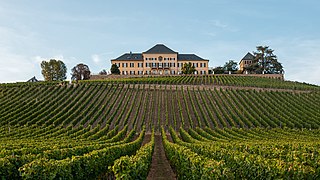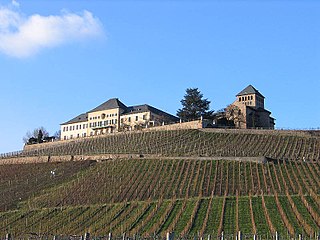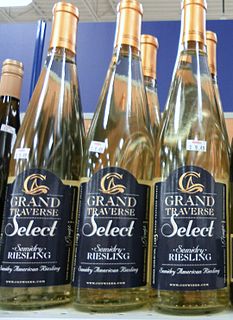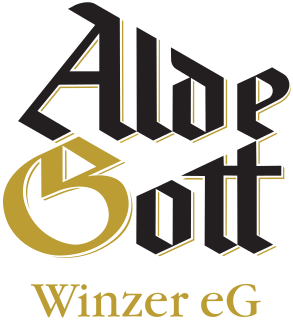
Riesling is a white grape variety that originated in the Rhine region. Riesling is an aromatic grape variety displaying flowery, almost perfumed, aromas as well as high acidity. It is used to make dry, semi-sweet, sweet, and sparkling white wines. Riesling wines are usually varietally pure and are seldom oaked. As of 2004, Riesling was estimated to be the world's 20th most grown variety at 48,700 hectares, but in terms of importance for quality wines, it is usually included in the "top three" white wine varieties together with Chardonnay and Sauvignon blanc. Riesling is a variety that is highly "terroir-expressive", meaning that the character of Riesling wines is greatly influenced by the wine's place of origin.

German wine is primarily produced in the west of Germany, along the river Rhine and its tributaries, with the oldest plantations going back to the Roman era. Approximately 60 percent of German wine is produced in the state of Rhineland-Palatinate, where 6 of the 13 regions (Anbaugebiete) for quality wine are situated. Germany has about 103,000 hectares of vineyard, which is around one tenth of the vineyard surface in Spain, France or Italy. The total wine production is usually around 10 million hectoliters annually, corresponding to 1.3 billion bottles, which places Germany as the eighth-largest wine-producing country in the world. White wine accounts for almost two thirds of the total production.

The German wine classification system puts a strong emphasis on standardization and factual completeness, and was first implemented by the German Wine Law of 1971. Nearly all of Germany's vineyards are delineated and registered as one of approximately 2,600 Einzellagen, and the produce from any vineyard can be used to make German wine at any quality level, as long as the must weight of the grapes reaches the designated minimum level. As the current German system does not classify vineyards by quality, the measure of wine ’quality’ is the ripeness of the grapes alone.

Sylvaner or Silvaner is a variety of white wine grape grown primarily in Alsace and Germany, where its official name is Grüner Silvaner. While the Alsatian versions have primarily been considered simpler wines, it was included among the varieties that can be used to produce Alsace Grand Cru wine in 2006, together with the four 'noble grapes' of Alsace, although only in one vineyard, Zotzenberg.

Eltville am Rhein is a town in the Rheingau-Taunus-Kreis in the Regierungsbezirk of Darmstadt in Hesse, Germany. It lies on the German Timber-Frame Road.
The glossary of wine terms lists the definitions of many general terms used within the wine industry. For terms specific to viticulture, winemaking, grape varieties, and wine tasting, see the topic specific list in the "See also" section below.

Eberbach Abbey is a former Cistercian monastery in Eltville in the Rheingau, Germany. On account of its Romanesque and early Gothic buildings it is considered one of the most significant architectural heritage sites in Hesse.

Schloss Johannisberg is a schloss and winery in the village of Johannisberg to the west of Wiesbaden, Hesse, in the Rheingau wine-growing region of Germany. It has been making wine for over 900 years. The winery is most noted for its claim to have "discovered" late harvest wine. The palace is a venue of the Rheingau Musik Festival, made available by co-founder Tatiana von Metternich-Winneburg.

Rheingau is one of 13 designated German wine regions (Weinbaugebiete) producing quality wines . It was named after the traditional region of Rheingau, the wine region is situated in the state of Hesse, where it constitutes part of the Rheingau-Taunus-Kreis administrative district. Although, making up only 3 percent of the total German vineyard area, Rheingau has been the source of many historically important innovations in German wine making, and contains many wine producers of international reputation, such as Schloss Johannisberg. Rheingau, with 3,125 hectares of vineyards in 2016, also boasts a higher proportion of Riesling (77.7%) than any other German wine-growing region, with Spätburgunder making up most of the rest (12.2%), followed by Müller-Thurgau.

A number of German wine auctions are held each year, where the premier German wine producers auction off some of the best young wines, as well as some older wines. Most auctions are arranged by the regional associations of Verband Deutscher Prädikats- und Qualitätsweingüter (VDP). These auctions differ from wine auctions on the second-hand market held by auction houses, where collectible wines are sold by private or corporate owners, since it is "first hand" wines that are sold.

Franconia is a region for quality wine in Germany situated in the north west of Bavaria in the district of Franconia, and is the only wine region in the federal state of Bavaria. In 2014, vines were grown on 6,176 hectares of land in the region.

The Hessische Bergstraße is a defined region (Anbaugebiet) for wine in Germany located in the state of Hesse among the northern and western slopes of the Odenwald mountain chain. With only 467 hectares of vineyards it is the smallest of the 13 German quality wine regions. At 21% red grape varieties and 79% white varieties, it is planted with primarily Riesling, Pinot gris (12%) and Spätburgunder. Hessische Bergstraße is divided into two districts (Bereiche) - Umstadt and Starkenburg - three collective vineyard sites and 24 individual vineyard sites.

Schloss Vollrads is a castle and a wine estate in the Rheingau wine-growing region in Germany. It has been making wine for over 800 years.
Jidvei wines are nurtured in Romania, within the Târnave wine region, along the two Târnave rivers: Târnave Mica and Târnava Mare. The Târnave region is situated in Jidvei, Alba County.

Nova Scotia wine is Canadian wine produced in the Canadian province of Nova Scotia. Nova Scotia's wineries are primarily organized under the Wine Association of Nova Scotia, though not all wineries are members. The industry began in the late 1970s with the original Grand Pré Winery in the Annapolis Valley of Nova Scotia.

Chateau Grand Traverse is a Michigan winery located in the Old Mission Peninsula AVA around Traverse City. The winery was founded by Edward O'Keefe Jr. and is notable for having the first large-scale planting of Vitis vinifera in Michigan. O'Keefe and Chateau Grand Traverse were also the driving force behind the establishment of an American Viticultural Area on the Old Mission Peninsula back in the 1980s when the estate was the only commercial winery on the peninsula. In 1980, the winery produced Michigan's first commercial ice wine and the 1987 vintage of Chateau Grand Traverse Johannisberg Riesling Ice Wine was served at the presidential inauguration of George H. W. Bush.

Red Willow Vineyard is a grape-growing estate located in the far western end of Yakima Valley AVA, within the Yakama Indian Reservation. Beginning with their relationship with Columbia Winery and Master of Wine David Lake, grapes from Red Willow have been used to produce some of the most critically acclaimed Washington wines with the vineyard's name regularly being featured on vineyard designated wines. Paul Gregutt, wine writer for the Seattle Times and Wine Enthusiast, list Red Willow as one of the "top ten" vineyards in the entire state.
Weingut Heinrich Vollmer is a German winery situated in Ellerstadt/Palatinate.

The Alde Gott Winzer eG was founded in Sasbachwalden (Germany) in 1948 and is part of the wine-growing region Baden. Today, there are 380 producers who cultivate 263 hectare of vines. Günter Lehmann runs the Alde Gott Winery eG as the general manager while cellarer Michael Huber is responsible for the winemaking.

Niersteiner Glöck is a 2.1 hectares wall-enclosed vineyard in Nierstein in Rheinhessen, Germany. It is the oldest named vineyard site in Germany.





















